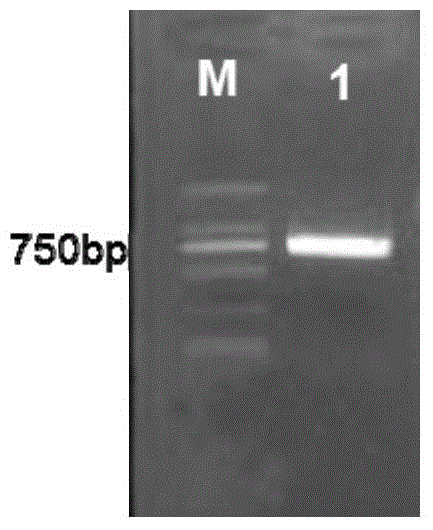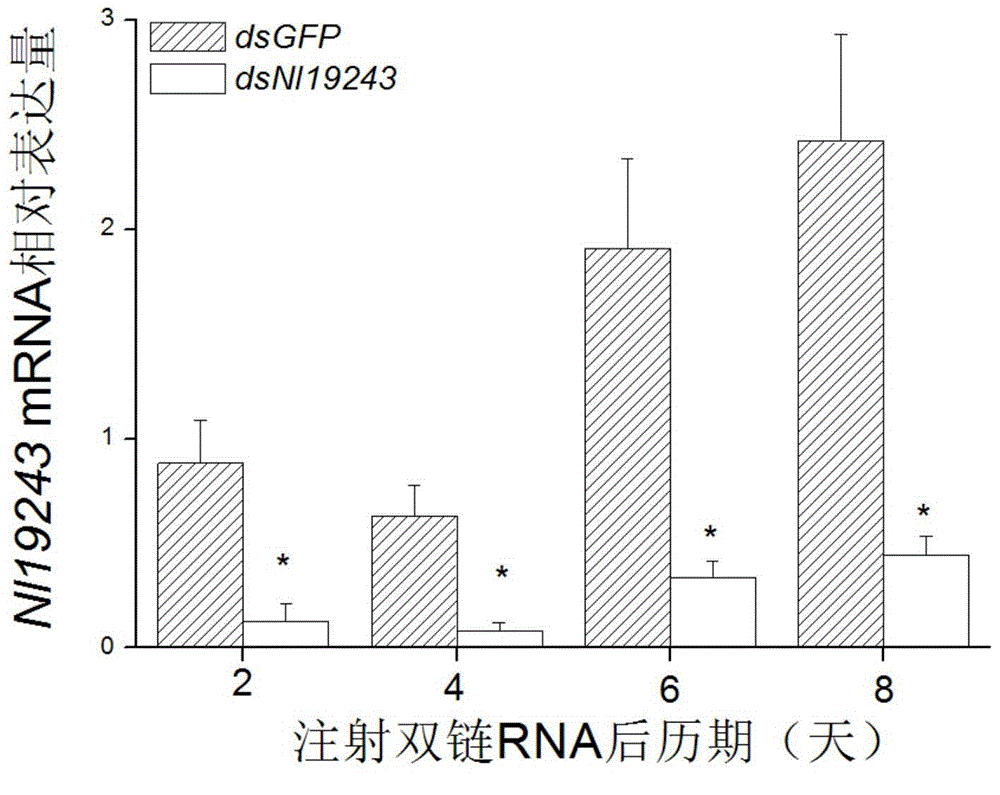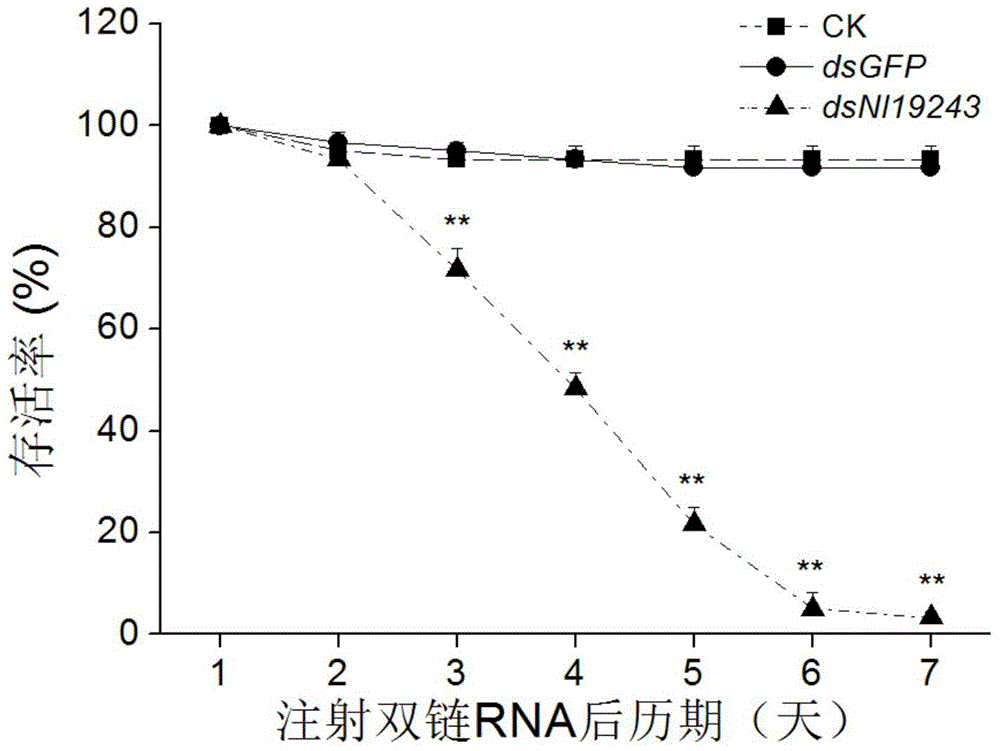A brown planthopper gene nl19243 and its encoded product and application
A brown planthopper and transgenic plant technology, applied in the application, genetic engineering, plant gene improvement and other directions, can solve the problems of no brown planthopper cloned, reduce related genes, and the lethal effect of brown planthopper is not obvious, and achieve the promotion of rice planthopper resistance breeding, good The effect of anti-insect effect
- Summary
- Abstract
- Description
- Claims
- Application Information
AI Technical Summary
Problems solved by technology
Method used
Image
Examples
Embodiment 1
[0029] Embodiment 1, Nl19243 Gene acquisition and sequence analysis
[0030] 1) Extraction, quality inspection and first-strand synthesis of total cDNA from salivary gland RNA of brown planthopper;
[0031] 2) Synthesized by polymerase chain reaction (PCR) from the first strand of total cDNA Nl19243 CDS Fragment
[0032] Upstream primer (SEQ ID No.3): 5'- GTCCCGTTCACGACACTA -3'
[0033] Downstream primer (SEQ ID No.4): 5'- TCTGATATTTCAACTGCCTC -3'
[0034] PCR amplification conditions: 98°C×3min→(98°C×30sec→55°C×30sec→72°C×50sec)×30 cycles→72°C×10min, see attached figure 1 .
[0035] 3) pMD19- Nl19243 Cloning vector construction and gene base analysis
[0036] The PCR product was cloned into the pMD19-T vector of Takara Company to obtain pMD19- Nl19243 vector, and transformed into TG1 Escherichia coli by heat shock method, will contain pMD19- Nl19243 The carrier TG1 bacterial liquid was sent to Nanjing GenScript Company for sequencing. Sequence alignment analysis w...
Embodiment 2
[0037] Embodiment 2, brown planthopper Nl19243 dsRNA synthesis and injection RNAi effect
[0038] 1) From the above pMD19- Nl19243 Obtained by polymerase chain reaction (PCR) in the cloning vector Nl19243 The middle 425bp fragment, and continue to synthesize Nl19243 dsRNA fragments. At the same time with GFP Plasmid as template, obtained by PCR GFP The middle 860bp fragment, and continue to synthesize GFP dsRNA fragment
[0039] ds Nl19243 -T7-F (SEQ ID No. 5):
[0040] 5’- GGATCCTAATACGACTCACTATAGG TGGCTCACTCGTACTTCTT-3’
[0041] ds Nl19243 -T7-R (SEQ ID No. 6):
[0042] 5'- GGATCCTAATACGACTCACTATAGG CCACTTCACTCCGTCCTG -3'
[0043] ds GFP -T7-F (SEQ ID No. 7):
[0044] 5'-GGATCCTAATACGACTCACTATAGGAAGGGCGAGGAGCTGTTCACCG-3'
[0045] ds GFP- T7-R (SEQ ID No. 8):
[0046] 5'-GGATCCTAATACGACTCACTATAGGCAGCAGGACCATGTGATCGCGC-3'
[0047] PCR amplification conditions:
[0048] Nl19243 : 98℃×3min→(98℃×30sec→62℃×30sec→72℃×30sec)×30 cycles→72℃×10min
[0049] ...
Embodiment 3
[0062] Embodiment 3, transgene Nl19243 Studies on the function of dsRNA against insects in rice
[0063] 1. Design forward and reverse primers, PCR amplify the 425bp long 155th to 579th Nl19243 genetic DNA fragment.
[0064] 2. DNA subcloning Nl19243 The gene fragment is inserted into the pMECE vector forward and reverse at the same time, and the forward and reverse connections are obtained. Nl19243 Gene fragment RNAi expression vector pMECE- Nl19243 ( Figure 4 ).
[0065] 3. Add pMECE- Nl19243 , into Agrobacterium EHA105 by electric shock method to obtain Agrobacterium engineered cell line. The rice callus was infected by Agrobacterium transfection method, and the co-infected rice callus was cultured on NBDS medium containing hygromycin, and the first selection was 20 days. After the new resistant callus grows, the resistant callus is stripped from the parent body and transferred to a new selection medium NBDS2, and one resistant callus is a strain. After the resis...
PUM
| Property | Measurement | Unit |
|---|---|---|
| area | aaaaa | aaaaa |
Abstract
Description
Claims
Application Information
 Login to View More
Login to View More - R&D
- Intellectual Property
- Life Sciences
- Materials
- Tech Scout
- Unparalleled Data Quality
- Higher Quality Content
- 60% Fewer Hallucinations
Browse by: Latest US Patents, China's latest patents, Technical Efficacy Thesaurus, Application Domain, Technology Topic, Popular Technical Reports.
© 2025 PatSnap. All rights reserved.Legal|Privacy policy|Modern Slavery Act Transparency Statement|Sitemap|About US| Contact US: help@patsnap.com



